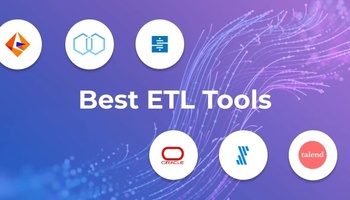Azure Synapse Analytics, still commonly known as Azure Data Warehouse, is Microsoft's cloud data warehouse that processes relational and non-relational data for analytics. As one of the most popular data warehousing tools, Azure lets you generate real-time insights into almost every aspect of your business, from sales to customer service. But how do you get data to Azure in the first place? That's where an Extract, Transform, and Load (ETL) tool proves useful. It's a platform that extracts data from sources like Salesforce, relational databases, customer relationship management (CRM) systems, enterprise resource planning (ERP) systems, and more. Then it transforms that data into the correct format for analytics and loads it to the Azure data warehouse. There's little (or no) code involved so you can save money on data engineers. There are several ETL tools for Azure Data Warehouse available on the market. All of these platforms do the same thing: They move your data to Azure so you can run that data through business intelligence (BI) tools for deep data insights. But which of these tools provides the biggest bang for your buck? Here are the best ETL tools for Azure Data Warehouse based on price, features, capabilities, and other factors.
Integrate.io is a no-code ETL tool that moves data to Azure Data Warehouse without the hassle. Just use its out-of-the-box connector for Azure and generate business intelligence that drives your organizational goals. Schedule a 7-day demo now. Integrate.io
Integrate.io
Integrate.io is one of the most reliable ETL tools for Azure Data Warehouse. It comes with over 100 out-of-the-box connectors that sync data to warehouses like Azure, as well as data lakes and other destinations. Integrate.io takes care of the entire ETL process for your team, so there's no need to build data pipelines or hire expensive data engineers. Here's how it works:
- Integrate.io extracts data from your relational database, CRM, ERP, or another system. There's no code required.
- It transforms the data into the correct format for third-party BI tools, removes data inconsistencies, and improves data quality.
- It loads data to Azure so you can run it through BI tools for analytical purposes.
Integrate.io pricing is tailored exactly to each client's needs and requirements with a usage-based component couple with features and functionality. Clients choose which level of platform usage they will require and then which features and functionality to create a custom plan to fit their use case. Other Integrate.io features include:
- A REST API.
- Top-tier customer service, including telephone and email support.
- Online guides and tutorials.
- A Salesforce-to-Salesforce connector that moves Salesforce data to Azure and then back again.
- Streamlined workflows.
- A simple drag-and-drop interface.
- Connectors for other data warehouses like Snowflake and Redshift.
- A user score of 4.3/5 on the software website G2.com, making it one of the highest-rated ETL tools for Azure Data Warehouse.
Here's what some users say about Integrate.io:
- "Clear UI, easy to use, and implement. The number of ETL functionalities is very impressive."
- "Intuitive interface, a wide range of data source connections, powerful data manipulation tools, and excellent customer support eager to help."
- "Most of Integrate.io's customer success engineers are amazing."
Fivetran
If you're searching for ETL tools for Azure Data Warehouse, Fivetran might provide a solution. It migrates data from its source to Microsoft's cloud data warehouse in mere minutes so you can push that data through BI software and generate real-time data reports. However, Fivetran reverses the 'transform' and 'load' stages of the ETL process, meaning it doesn't change data to the correct format for analytics until it loads that data to Azure. This process is called Extract, Load, Transform, or ELT.ELT might suit organizations that don't need to process large amounts of data. Those that do will soon learn that Fivetran struggles with bigger data loads, making alternative ETL tools for Azure Data Warehouse a better option in some use cases. Still, Fivetran has lots of features that make it a worthwhile investment, including excellent customer service and a good selection of native no-code connectors. Unlike Integrate.io, the platform uses a volume-based pricing model that charges customers for the amount of data consumed. Read more: Fivetran vs. Integrate.io
Stitch
Stitch handles large data loads like Integrate.io (its primary data transfer method is ETL, not ELT). However, it has limited transformation abilities, focusing on 'extract' and 'load.' This method might suit companies with data that doesn't require lots of transformation — for example, Salesforce data — but it restricts users that want to convert legacy data into a usable format for analytics. On the flip side, Stitch comes with over 100 native connectors that make pipeline-building easy, as well as a reliable customer service team. You can also scale Stitch as your data requirements grow. Learn more: Stitch vs. Integrate.io
Matillion
Like Fivetran, Matillion reverses the 'T' and 'L' components of ETL and transforms data into the correct format for analytics after loading it to Azure. Again, this method might suit smaller teams. Another thing to consider is that Matillion uses Azure for processing power. Unlike Integrate.io, this platform doesn't have a data engine. The positive: Matillion comes with an excellent selection of connectors that sync various sources and destinations on top of Azure. You can also code custom scripts in Python and SQL for even more advanced data pipelines. Learn more: Matillion vs. Integrate.io
Azure Data Factory
Azure Data Factory is Microsoft's ETL service that syncs data from various sources to Azure Data Warehouse. While this method is quick and easy, it comes with limitations. Data Factory essentially only offers native connectors for Microsoft services, so you won't be able to migrate data to other warehouses, lakes, or data stores. There's some support for third-party systems like Redshift, but the number of available connectors is far fewer than all the other ETL tools on this list. Read more: Understanding Microsoft ETL with Azure Data Factory
How Integrate.io Can Help You When Comparing ETL Tools for Azure Data Warehouse
All the ETL tools listed above successfully move data to Azure for analytics, so the platform you should choose depends on your requirements. If you have smaller data loads, you might benefit from a tool that transforms data after it loads it to Azure, like Fivetran or Matillion. However, these platforms might prove useless when you scale your business or if your data requirements change. You could use Microsoft's ETL tool, Azure Data Factory. However, this platform primarily benefits Microsoft users, and it's difficult to build pipelines for other warehouses or systems. Integrate.io is the best choice for Azure data migration because it has ETL and ELT capabilities and syncs with over 100 sources and destinations. You can benefit from world-class customer service, a simple pricing model, a drag-and-drop interface, and more. Want to move data to Azure? Schedule a 7-day demo with Integrate.io and learn more about one of the best tools for Azure Data Warehouse.










